Synthetic Evaluation of China’s Regional Low-Carbon Economy Challenges by Driver-Pressure-State-Impact-Response Model
Abstract
1. Introduction
2. Theoretical Framework
3. Methodology
4. Data and Variables
4.1. Measurement of CO2 Emissions from Energy Consumption
4.2. Other Data and Variables
5. Regional Evaluation of the Low-Carbon Economy
5.1. Index Calculation
5.2. Dimensionless Evaluation Factors
5.3. Weight of Evaluation Factors
5.4. The synthetic Index and Sub-Index of the Low-Carbon Economy
6. Assessing Coupling Coordination between the Sub-Indexes
7. Results and Analysis
7.1. Results
7.2. Analysis of DPSR Sub-Indexes
7.3. Analysis of the Degree of Coordination among the Four Sub-Indexes
8. Conclusions
Author Contributions
Funding
Conflicts of Interest
References
- IPCC. Climate Change 2014: Synthesis Report; IPCC: Geneva, Switzerland, 2014; p. 151.
- Michalena, E.; Kouloumpis, V.; Hills, J.M. Challenges for Pacific Small Island Developing States in achieving their Nationally Determined Contributions (NDC). Energy Policy 2018, 114, 508–518. [Google Scholar] [CrossRef]
- UNFCCC. Adoption of the Paris Agreement. In Proceedings of the Conference of the Parties, 21 session, Durban Platform for Enhanced Action, Paris, France, 20 November–11 December 2016; Available online: https://unfccc.int/resource/docs/2015/cop21/eng/l09r01.pdf (accessed on 20 May 2020).
- Boucher, O.; Bellassen, V.; Benveniste, H.; Ciais, P.; Criqui, P.; Guivarch, C.; Le Treut, H.; Mathy, S.; Séférian, R. In the wake of Paris agreement, scientists must embrace new directions for climate change research. Proc. Natl. Acad. Sci. USA 2016, 113, 7287–7290. [Google Scholar] [CrossRef] [PubMed]
- Bohringer, C.; RMoslener, T.F. Transition towards a low carbon economy: A computable general equilibrium analysis for Poland. Energy Policy 2013, 55, 16–26. [Google Scholar] [CrossRef]
- Andrew, R.; Forgie, V.A. three-perspective view of greenhouse gas emission responsibilities in New Zealand. Ecol. Econ. 2008, 68, 194–204. [Google Scholar] [CrossRef]
- Alexander, C. Micropolitan areas and urbanization processes in the US. Cities 2012, 29, 24–28. [Google Scholar]
- Chen, G.Q.; Zhang, B. Greenhouse gas emissions in China 2007: Inventory and input–output analysis. Energy Policy 2010, 38, 6180–6193. [Google Scholar] [CrossRef]
- Huang, Y.; Sun, W. Changes in topsoil organic carbon of croplands in mainland China over the last two decades. Chin. Sci. Bull. 2006, 51, 1785–1803. [Google Scholar] [CrossRef]
- Pramit, V.; Raghubanshi, A.S. Urban sustainability indicators: Challenges and opportunities. Ecol. Indic. 2018, 93, 282–291. [Google Scholar]
- IEA. CO2 Emissions from Fuel Combustion 2009 Highlights. 2009. Available online: http://www.iea.org/co2highlights/co2highlights.pdf (accessed on 18 May 2020).
- Yan, Y.F.; Yang, L. China’s foreign trade and climate change: A case study of CO2 emissions. Energy Policy 2010, 38, 350–356. [Google Scholar]
- Wang, S.; Li, Y. Application of projection pursuit model in regional eco-environment quality assessment. Chin. J. Ecol. 2006, 25, 869–872. [Google Scholar]
- Hughes, N.; Strachan, N. Methodological review of UK and international low carbon scenarios. Energy Policy 2010, 38, 6056–6065. [Google Scholar] [CrossRef]
- Zhuang, G.Y.; Pan, J.H.; Zhu, S.X. Conceptual Identification and Evaluation Index System for Low Carbon Economy. J. Econ. Perspect. 2011, 13, 132–136. [Google Scholar]
- Gregory, A.; Atkins, J.; Burdon, D. A problem structuring method for ecosystem-based management: The DPSIR modelling process. Eur. J. Oper. Res. 2013, 227, 558–569. [Google Scholar] [CrossRef]
- Daniels, L. Climate change, economics and Buddhism Part I: An integrated environmental analysis framework. Ecol. Econ. 2010, 69, 952–961. [Google Scholar] [CrossRef]
- Elliott, M. The role of the DPSIR approach and conceptual models in marine environmental management: An example for offshore wind power. Mar. Pollut. Bull. 2002, 44, 3–7. [Google Scholar] [CrossRef]
- Vang, T.; Block, C.; Geens, J. Environmental response indicators for the industrial and energy sector in flander. J. Clean. Prod. 2006, 25, 75–86. [Google Scholar]
- Gray, J.S.; Elliott, M. Ecology of Marine Sediments-From Science to Management, 2nd ed.; Oxford University Press: Oxford, UK, 2009; pp. 56–59. ISBN 978-0-1985-6902-2. [Google Scholar]
- Krajnc, D.; Glavic, P. A model for integrated assessment of sustainable development. Resour. Conserv. Recy. 2005, 43, 189–208. [Google Scholar] [CrossRef]
- Atkins, J.P.; Burdon, D.; Elliott, M.; Gregory, A.J. Management of the marine environment: Integrating ecosystem services and societal benefits with the DPSIR framework in a systems approach. Mar. Pollut. Bull. 2011, 62, 215–226. [Google Scholar] [CrossRef]
- Maxim, L.; Joachim, H. An analysis of risks for biodiversity under the DPSIR framework. Ecol. Econ. 2009, 69, 12–23. [Google Scholar] [CrossRef]
- Ness, B.; Anderberg, S.; Olsson, L. Structuring problems in sustainability science: The multi-level DPSIR framework. Geoforum 2010, 41, 479–488. [Google Scholar] [CrossRef]
- Manjot, K.; Kasun, H.; Rehan, S. Investigating the impacts of urban densification on buried water infrastructure through DPSIR framework. Sustainability 2020, 20, 120897. [Google Scholar]
- Qu, S.; Hu, S.; Li, W.; Wang, H.; Zhang, C.; Li, Q. Interaction between urban land expansion and land use policy: An analysis using the DPSIR framework. Land Use Policy 2020, 99, 104856. [Google Scholar] [CrossRef]
- Shen, Y.C.; Fu, Y.Y.; Song, M.L. Coupling relationship between green production and green consumption: Case of the Yangtze River Delta area. Nat. Resour. Model. 2019, 8, 134–138. [Google Scholar] [CrossRef]
- Satty, T.L. A scaling method for priorities in hierarchical structures. J. Math. Psychol. 1977, 15, 234–281. [Google Scholar] [CrossRef]
- Nachiappan, S.; Ramakrishnan, R. A review of applications of Analytic Hierarchy Process in operations management. Int. J. Prod. Res. 2012, 138, 215–241. [Google Scholar]
- Xiong, Y.; Zeng, G.M. Combining AHP with GIS in synthetic evaluation of eco-environment quality—A case study of Hunan Province, China. Ecol. Modell. 2007, 209, 97–109. [Google Scholar]
- Li, Z.W.; Zeng, G.M.; Zhang, H. The Integrated Eco-environment Assessment of the Red Soil Hilly Region Based on GIS—A Case Study in Changsha City, China. Ecol. Modell. 2007, 202, 540–546. [Google Scholar] [CrossRef]
- Solnes, J. Environmental quality indexing of large industrial development alternatives using AHP. Environ. Environ. Impact Assess. Rev. 2003, 23, 283–303. [Google Scholar] [CrossRef]
- Chatzimouratidis, A.I.; Pilavachi, P.A. Technological, economic and sustainability evaluation of power plants using the Analytic Hierarchy Process. Energy Policy 2009, 37, 778–787. [Google Scholar] [CrossRef]
- Saaty, T.L.; Vargas, L.G. Models, Methods, Concepts & Applications of the Analytic Hierarchy Process. Int. Ser. Oper. Res. Manag. Sci. 2012, 175, 149–158. [Google Scholar]
- Omasa, T.; Kishimoto, M.; Kawase, M. An attempt at decision making in tissue engineering: Reactor evaluation using the analytic hierarchy process (AHP). Biochem. Eng. J. 2004, 20, 173–179. [Google Scholar] [CrossRef]
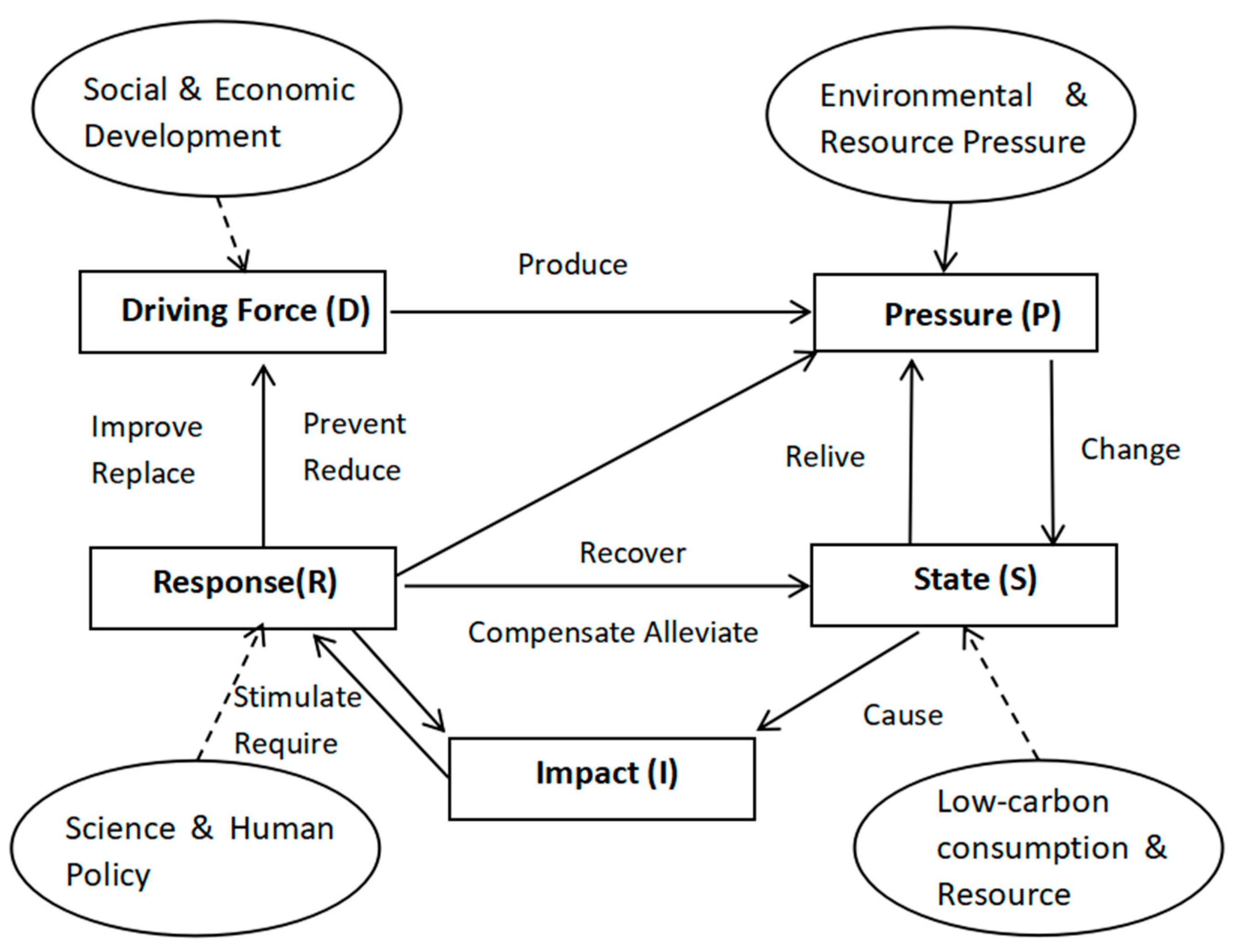
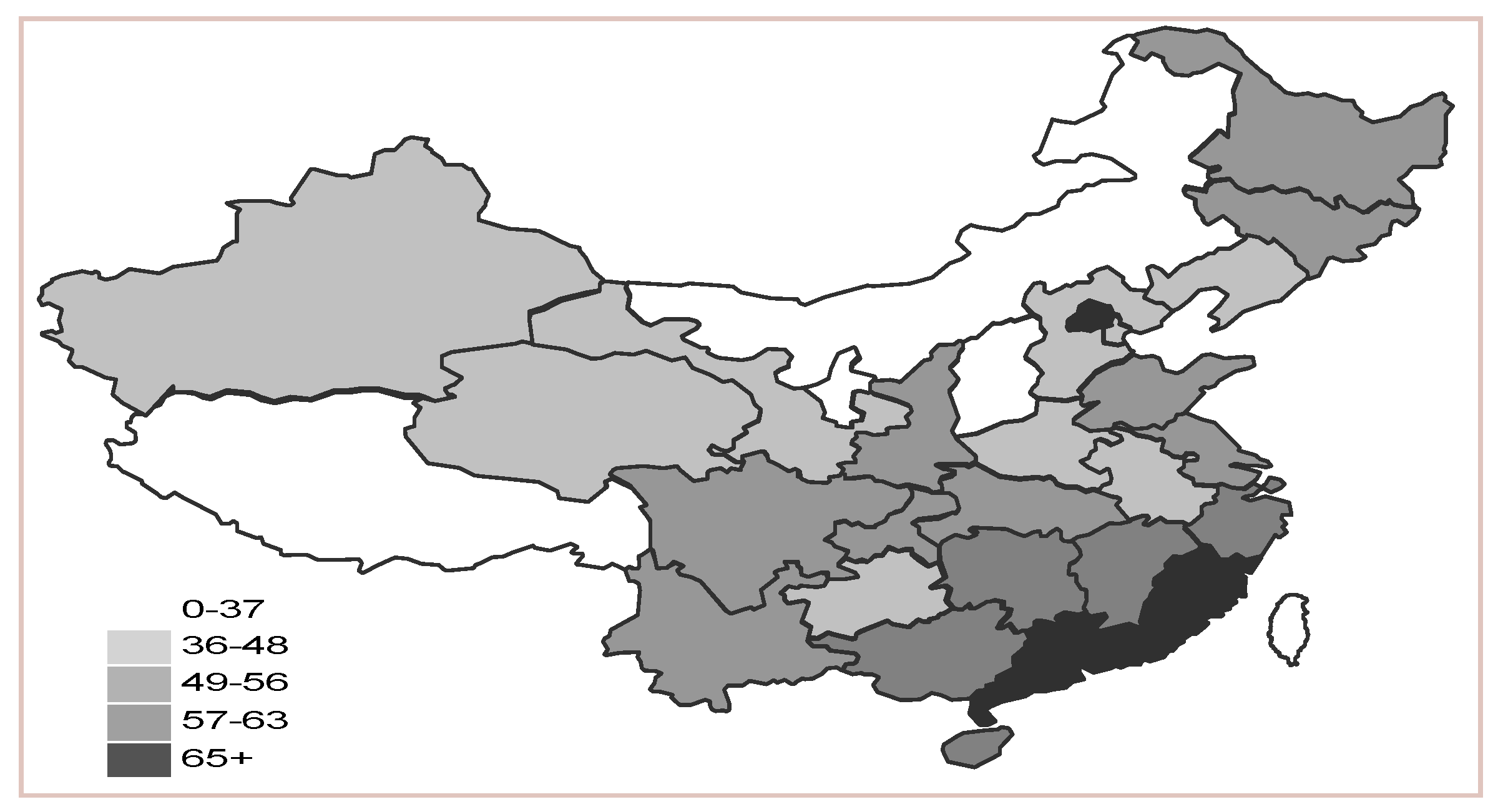


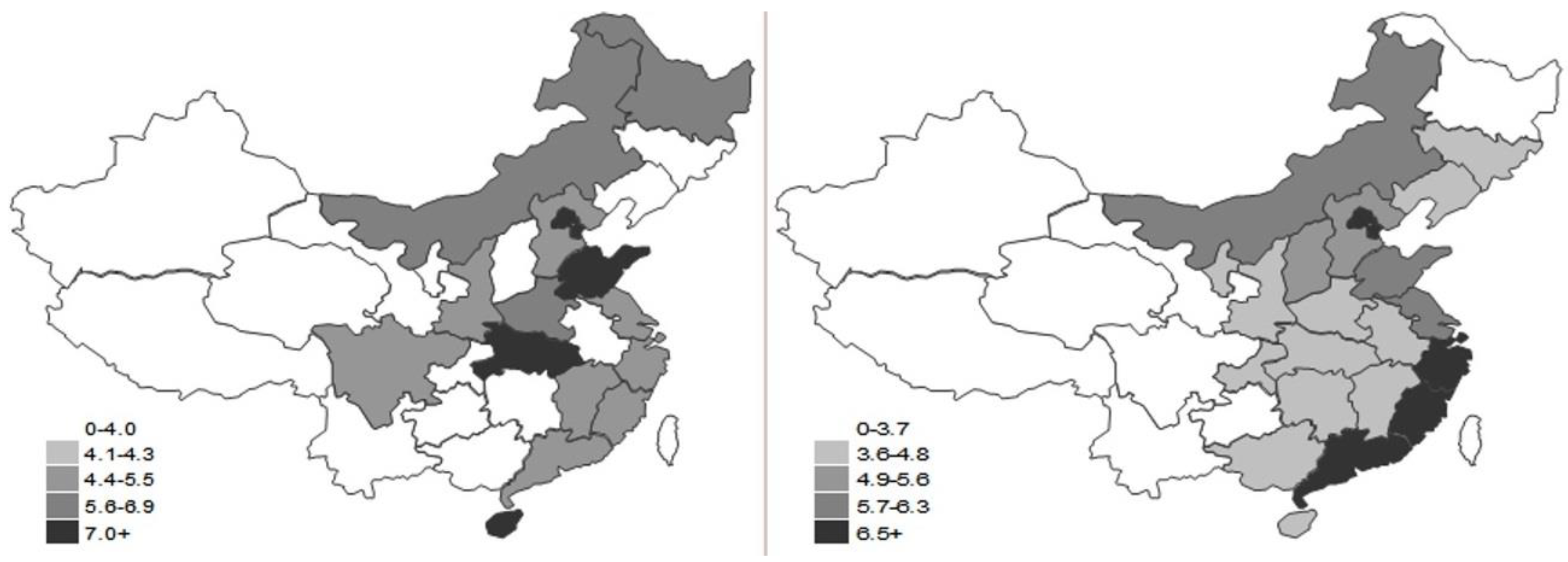
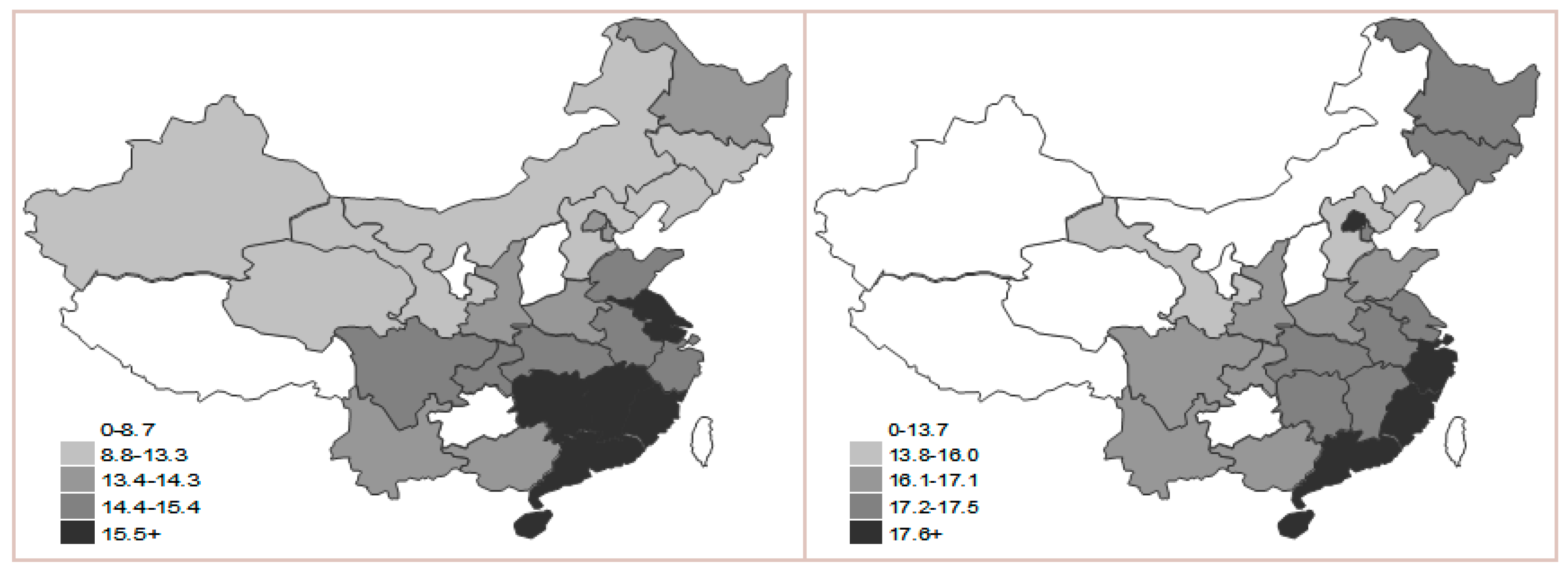
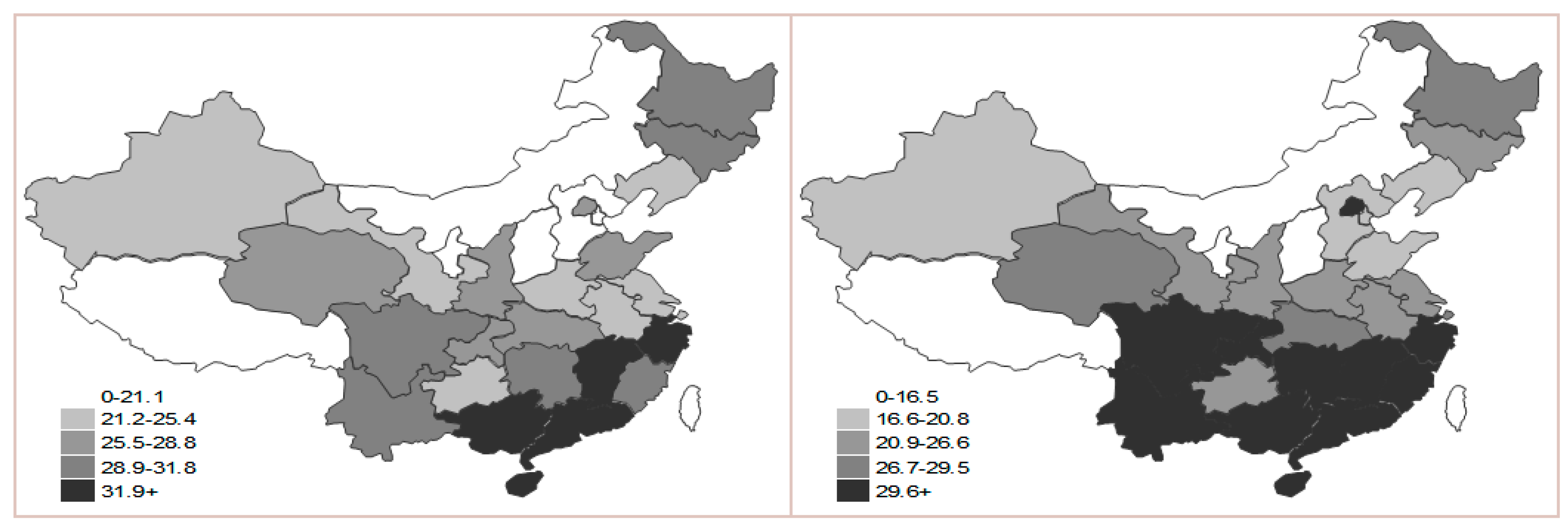

| First Grade | Second Grade | Weight | Third Grade | Weight | Fourth Grade | Weight | Positive or Negative |
|---|---|---|---|---|---|---|---|
| Comprehensive level of low-carbon economy (A) | Driver (D) | 0.1186 | Driver for social development (D1) | 0.0593 | Natural Population Growth (D11, ‰) | 0.0272 | Moderate |
| Urbanization Rate (D12, %) | 0.0247 | Moderate | |||||
| Engel’s coefficient on urban and rural households (D13, %) | 0.0075 | Negative | |||||
| Driver for economic development (D2) | 0.0593 | per capita GDP (D21, yuan per capita) | 0.0183 | Positive | |||
| GDP growth rate (D22, %) | 0.0065 | Positive | |||||
| The average income of rural and urban family (D23, yuan per capita) | 0.0345 | Positive | |||||
| Pressure (P) | 0.2162 | resource pressure (P1) | 0.0865 | The energy consumption per unit of GDP (P11, tons of coal per 10,000 yuan) | 0.0605 | Negative | |
| Electricity consumption per capita (P12, kwh per capita) | 0.0259 | Negative | |||||
| environmental pressure (P2) | 0.1297 | The industrial waste-gas discharge per unit of GDP (P21, cubic meter per 10,000 yuan) | 0.0741 | Negative | |||
| SO2 emission per unit of GDP (P22, ton per 10,000 yuan) | 0.0371 | Negative | |||||
| Public transportations per 10,000 people (P23) | 0.0185 | Positive | |||||
| Status (S) | 0.4141 | Status of low-carbon consumption (S1) | 0.2071 | Carbon emissions per capita (S11, ton per capita) | 0.1305 | Negative | |
| The carbon emissions of residents’ consumption (S12, ton per 10,000 yuan) | 0.0541 | Negative | |||||
| The carbon emissions of government consumption (S13, ton per 10,000 yuan) | 0.0225 | Negative | |||||
| Status of low-carbon resources (S2) | 0.2071 | Proportion of consumption of raw coal (S21, %) | 0.0941 | Negative | |||
| Carbon emissions per unit of energy (S22, ton of CO2 per ton of coal) | 0.0188 | Negative | |||||
| Forest coverage (S23, %) | 0.0941 | Positive | |||||
| Response (R) | 0.2511 | Scientific Response (R1) | 0.1758 | Expenditure on science and technology per capita (R11, yuan per capita) | 0.0189 | Positive | |
| The efficiency of energy process and conversion (R12, %) | 0.0181 | Positive | |||||
| Carbon productivity (R13, 10,000 yuan per ton) | 0.1387 | Positive | |||||
| Policy Response (R2) | 0.0753 | The proportion the tertiary industry output value accounts for GDP (R21, %) | 0.0442 | Positive | |||
| The development plan of low-carbon economy (R22) | 0.0077 | Positive | |||||
| Policy of carbon tax (R23) | 0.0081 | Positive | |||||
| Supervision and statistics system of carbon emissions (R24) | 0.0154 | Positive |
| Coordination Degree | Coordination Level | Coordination Degree | Coordination Level |
|---|---|---|---|
| 0.01 < CD2 ≤ 0.10 | Extreme disorder ≤ | 0.51 < CD2 ≤ 0.60 | Bare coordination |
| 0.11 <CD2 ≤ 0.20 | Serious disorder | 0.61 < CD2 ≤ 0.70 | Primary coordination |
| 0.21 <CD2 ≤ 0.30 | Moderate disorder | 0.71 < CD2 ≤0.80 | Intermediate coordination |
| 0.31 <CD2 ≤ 0.40 | Mild disorder | 0.81 < CD2 ≤0.90 | Favorable coordination |
| 0.41 <CD2 ≤ 0.50 | On the verge of disorder | 0.91 < CD2 ≤ 0.10 | Quality coordination |
| Energy Type | A | B | C = A × B × (44 / 12) × 1000 | D = C × 4186.8 × 10−9 × 10−3 | E | F = D × E | |||||
|---|---|---|---|---|---|---|---|---|---|---|---|
| IPCC (2006) | Oxidation Rate in the Combustion | IPCC (2006) | Original Coefficient | Calorific Value of Unit Fuel in China | Suggested Coefficient | ||||||
| Carbon Emission Coefficient | Measurement | CO2 Emission Coefficient | Measurement | Original Coefficient | Measurement | Average Calorific Value of Unit Fuel in China | Measurement | Coefficient | Measurement | ||
| Crude coal | 25.8 | kgC/GJ | 1 | 94,600 | kgCO2/TJ | 0.000396071 | kgCO2/Kcal | 5000 | Kcal/Kg | 1.98 | kgCO2/Kg |
| Coke | 29.2 | kgC/GJ | 1 | 107,066.67 | kgCO2/TJ | 0.000448267 | kgCO2/Kcal | 6800 | Kcal/Kg | 3.05 | kgCO2/Kg |
| Crude oil | 20 | kgC/GJ | 1 | 73,333.33 | kgCO2/TJ | 0.000307032 | kgCO2/Kcal | 10,000 | Kcal/Kg | 3.07 | kgCO2/Kg |
| Gasoline | 18.9 | kgC/GJ | 1 | 69,300 | kgCO2/TJ | 0.000290145 | kgCO2/Kcal | 10,300 | Kcal/Kg | 2.99 | kgCO2/Kg |
| Jet kerosene | 19.6 | kgC/GJ | 1 | 71,866.67 | kgCO2/TJ | 0.000300891 | kgCO2/Kcal | 10,300 | Kcal/Kg | 3.10 | kgCO2/Kg |
| Diesel oil | 20.2 | kgC/GJ | 1 | 74,066.67 | kgCO2/TJ | 0.000310102 | kgCO2/Kcal | 10,200 | Kcal/Kg | 3.16 | kgCO2/Kg |
| Fuel oil | 21.1 | kgC/GJ | 1 | 77,366.67 | kgCO2/TJ | 0.000323919 | kgCO2/Kcal | 10,000 | Kcal/Kg | 3.24 | kgCO2/Kg |
| Refinery gas | 16.8 | kgC/GJ | 1 | 61,600 | kgCO2/TJ | 0.000257907 | kgCO2/Kcal | 11,000 | Kcal/Kg | 2.84 | kgCO2/Kg |
| Natural gas | 15.3 | kgC/GJ | 1 | 56,100 | kgCO2/TJ | 0.000234879 | kgCO2/Kcal | 9310 | kgCO2/M3 | 2.19 | kgCO2/M3 |
| Liquefied petroleum gas | 17.2 | kgC/GJ | 1 | 63,066.67 | kgCO2/TJ | 0.000264048 | kgCO2/Kcal | 12,000 | kgCO2/M3 | 3.17 | kgCO2/M3 |
| Year | Crude Coal Consumption (104 Tons) | Coke Consumption (104 Tons) | Crude Oil Consumption (104 Tons) | Gasoline Oil Consumption (104 Tons) | Jet Kerosene Consumption (104 Tons) | Diesel Oil Consumption (104 Tons) | Fuel Oil Consumption (104 Tons) | Natural Gas Consumption (104 Tons) | CO2 Emissions |
|---|---|---|---|---|---|---|---|---|---|
| 1995 | 137,677 | 10,725.3 | 14,886.4 | 2910 | 512.1 | 4321 | 3693.7 | 177.4 | 49.46 |
| 1996 | 144,734.46 | 11,865 | 15,865.01 | 3182.4 | 555.5 | 4825.14 | 3632.31 | 185.9 | 51.56 |
| 1997 | 139,248.26 | 10,927 | 17,367.2 | 3312 | 681.71 | 5291.21 | 3848.2 | 196.44 | 51.58 |
| 1998 | 129,492.2 | 11,447.82 | 17,395.31 | 3328.6 | 706.41 | 5309.7 | 3828.6 | 202.6 | 49.77 |
| 1999 | 139,336.5 | 10,460.52 | 18,949.5 | 3389.3 | 824.21 | 6231.63 | 3934.11 | 214.94 | 52.58 |
| 2000 | 135,690 | 10,840.8 | 21,232 | 3505 | 871.6 | 6578.57 | 3872.8 | 245 | 52.64 |
| 2001 | 143,063 | 11,931.5 | 21,410.74 | 3597.6 | 890.3 | 6917.58 | 3850.22 | 274.3 | 54.55 |
| 2002 | 153,585 | 12,803.12 | 22,694.1 | 3804.32 | 919.2 | 7560.87 | 3723.9 | 292 | 57.16 |
| 2003 | 183,760 | 15,926.5 | 25,180.72 | 4118.52 | 921.61 | 8498.16 | 4330.34 | 339.1 | 67.21 |
| 2004 | 212,162 | 18,067.01 | 29,009.31 | 4695.72 | 1060.9 | 10,072.94 | 4844.8 | 397 | 77.04 |
| 2005 | 243,375 | 25,105.8 | 30,088.9 | 4855 | 1076.8 | 10,889.42 | 4244.2 | 466.1 | 84.06 |
| 2006 | 270,639 | 28,298 | 32,245.2 | 5242.55 | 1124.74 | 11,652.71 | 4471.2 | 573.33 | 92.20 |
| 2007 | 290,410 | 31,168.12 | 34,031.6 | 5519.1 | 1243.72 | 12,420.25 | 4157.5 | 705.23 | 96.89 |
| 2008 | 300,605 | 32,120.23 | 35,510.34 | 6145.52 | 1294.01 | 13,475.46 | 3236.8 | 813 | 97.20 |
| 2009 | 325,003 | 36,350 | 38,128.59 | 6172.69 | 1450.49 | 13,494.83 | 2828.8 | 895.2 | 102.87 |
| 2010 | 349,008 | 38,702.8 | 42,874.6 | 6956 | 1765.2 | 14,655.17 | 3758 | 1080.2 | 113.50 |
| 2011 | 388,961 | 42,063.3 | 43,965.8 | 7596 | 1816.7 | 15,593.54 | 3662.8 | 1341.1 | 122.97 |
| 2012 | 411,727 | 44,805.2 | 46,678.9 | 8166 | 1956.6 | 16,900.67 | 3683.3 | 1497 | 129.84 |
| 2013 | 424,426 | 45,851.9 | 48,652.2 | 9366 | 2164.1 | 17,106.75 | 3954 | 1705.4 | 134.65 |
| 2014 | 411,613 | 46,884.9 | 51,547 | 9776 | 2335.4 | 17,127.02 | 4400.5 | 1868.9 | 134.94 |
| 2015 | 397,014 | 44,058.7 | 54,088.3 | 11,368 | 2663.7 | 17,280.44 | 4662 | 1931.7 | 133.44 |
| 2016 | 384,560 | 45,462.4 | 56,025.9 | 11,866 | 2970.7 | 16,736.39 | 4631 | 2078.1 | 131.97 |
| A | D | P | S | R |
|---|---|---|---|---|
| D | 1 | 1/4 | 1/7 | 1/5 |
| P | 4 | 1 | 1/4 | 1/2 |
| S | 7 | 4 | 1 | 4 |
| R | 5 | 2 | 1/4 | 1 |
| Regions and Areas | 2000 | 2003 | 2007 | 2010 | 2015 | Average | |
|---|---|---|---|---|---|---|---|
| East area | Beijing | 0.5882 | 0.6603 | 0.7980 | 0.7829 | 0.8634 | 0.7386 |
| Tianjin | 0.3411 | 0.3505 | 0.5329 | 0.5340 | 0.5367 | 0.4590 | |
| Hebei | 0.3783 | 0.3715 | 0.3581 | 0.3881 | 0.4660 | 0.3924 | |
| Liaoning | 0.4309 | 0.4731 | 0.4136 | 0.4341 | 0.4443 | 0.4392 | |
| Shanghai | 0.5259 | 0.5750 | 0.6332 | 0.6509 | 0.5744 | 0.5919 | |
| Jiangsu | 0.4942 | 0.5364 | 0.5451 | 0.5581 | 0.5613 | 0.5390 | |
| Zhejiang | 0.6057 | 0.6564 | 0.6469 | 0.6721 | 0.6414 | 0.6445 | |
| Fujian | 0.6265 | 0.6241 | 0.6821 | 0.6832 | 0.6345 | 0.6501 | |
| Shandong | 0.5299 | 0.5250 | 0.4755 | 0.4623 | 0.4724 | 0.4930 | |
| Guangdong | 0.6256 | 0.6393 | 0.7191 | 0.7179 | 0.6618 | 0.6727 | |
| Hainan | 0.6299 | 0.6274 | 0.6862 | 0.6307 | 0.5528 | 0.6254 | |
| Average | 0.5251 | 0.5490 | 0.5901 | 0.5922 | 0.5826 | 0.5678 | |
| Central area | Shanxi | 0.2756 | 0.2484 | 0.2420 | 0.2315 | 0.2481 | 0.2491 |
| Inner Mongolia | 0.3232 | 0.3058 | 0.2181 | 0.2437 | 0.2763 | 0.2734 | |
| Jilin | 0.5001 | 0.4981 | 0.4843 | 0.4932 | 0.5051 | 0.4962 | |
| Heilongjiang | 0.5075 | 0.5535 | 0.5469 | 0.5176 | 0.5312 | 0.5313 | |
| Anhui | 0.4491 | 0.4673 | 0.4833 | 0.4943 | 0.5580 | 0.4904 | |
| Jiangxi | 0.5635 | 0.5855 | 0.5913 | 0.6032 | 0.5998 | 0.5887 | |
| Henan | 0.4452 | 0.4812 | 0.4452 | 0.4623 | 0.5291 | 0.4726 | |
| Hubei | 0.4957 | 0.5213 | 0.5254 | 0.5597 | 0.5741 | 0.5352 | |
| Hunan | 0.5963 | 0.6012 | 0.5755 | 0.6115 | 0.6025 | 0.5974 | |
| Guangxi | 0.5446 | 0.5641 | 0.5897 | 0.6170 | 0.5758 | 0.5782 | |
| Average | 0.4701 | 0.4826 | 0.4702 | 0.4834 | 0.5000 | 0.4813 | |
| West area | Chongqing | 0.5936 | 0.6194 | 0.4067 | 0.5733 | 0.5760 | 0.5538 |
| Sichuan | 0.5045 | 0.5237 | 0.5419 | 0.5956 | 0.5657 | 0.5463 | |
| Guizhou | 0.3203 | 0.3694 | 0.3351 | 0.4159 | 0.5176 | 0.3917 | |
| Yunnan | 0.4982 | 0.5059 | 0.4910 | 0.5487 | 0.5369 | 0.5161 | |
| Shaanxi | 0.5032 | 0.5078 | 0.5039 | 0.4795 | 0.4925 | 0.4974 | |
| Gansu | 0.3910 | 0.4013 | 0.4197 | 0.4389 | 0.4422 | 0.4186 | |
| Qinghai | 0.4259 | 0.4622 | 0.3845 | 0.4671 | 0.3813 | 0.4242 | |
| Ningxia | 0.2546 | 0.2366 | 0.1530 | 0.1505 | 0.1931 | 0.1976 | |
| Xinjiang | 0.4137 | 0.4530 | 0.3866 | 0.3323 | 0.2478 | 0.3667 | |
| Average | 0.4339 | 0.4533 | 0.4025 | 0.4447 | 0.4392 | 0.4347 | |
| Whole country | Average | 0.4791 | 0.4979 | 0.4933 | 0.5112 | 0.5073 | 0.4978 |
| Category one (Leading status) | Beijing, Guangdong, Hainan, Fujian, Zhejiang, Shanghai, Jiangxi, Guangxi, Hunan |
| Category two (Good status) | Heilongjiang, Sichuan, Jiangsu, Tianjin, Hubei, Shaanxi, Yunnan, Jilin, Anhui, Shandong |
| Category three (Medium status) | Chongqing, Henan, Gansu, Liaoning, Xinjiang, Qinghai, Hebei, Guizhou |
| Category four (Poor status) | Shanxi, Inner Mongolia, Ningxia |
| Regions and Areas | d(x) | p(y) | s(z) | p(k) | C | T | D | Coordination Level | |
|---|---|---|---|---|---|---|---|---|---|
| East area | Beijing | 0.0897 | 0.2108 | 0.3488 | 0.2142 | 0.8980 | 0.8634 | 0.8805 | Favorable coordination |
| Tianjin | 0.0696 | 0.1959 | 0.2401 | 0.0311 | 0.7486 | 0.5367 | 0.6338 | Primary coordination | |
| Hebei | 0.0468 | 0.1429 | 0.2593 | 0.0169 | 0.6314 | 0.4660 | 0.5424 | Bare coordination | |
| Liaoning | 0.0411 | 0.1494 | 0.2279 | 0.0259 | 0.6984 | 0.4443 | 0.5570 | Bare coordination | |
| Shanghai | 0.0847 | 0.1795 | 0.2541 | 0.0562 | 0.8451 | 0.5744 | 0.6968 | Primary coordination | |
| Jiangsu | 0.0668 | 0.1920 | 0.2719 | 0.0306 | 0.7241 | 0.5613 | 0.6375 | Primary coordination | |
| Zhejiang | 0.0777 | 0.1838 | 0.3493 | 0.0306 | 0.6933 | 0.6414 | 0.6668 | Primary coordination | |
| Fujian | 0.0696 | 0.1850 | 0.3619 | 0.0181 | 0.6038 | 0.6345 | 0.6189 | Primary coordination | |
| Shandong | 0.0589 | 0.1756 | 0.2203 | 0.0176 | 0.6740 | 0.4724 | 0.5643 | Bare coordination | |
| Guangdong | 0.0820 | 0.1906 | 0.3698 | 0.0194 | 0.6219 | 0.6618 | 0.6415 | Primary coordination | |
| Hainan | 0.0346 | 0.1789 | 0.3071 | 0.0322 | 0.6402 | 0.5528 | 0.5949 | Bare coordination | |
| Average | 0.0656 | 0.1804 | 0.2918 | 0.0448 | 0.7656 | 0.5826 | 0.6679 | Primary coordination | |
| Central area | Shanxi | 0.0427 | 0.0841 | 0.0906 | 0.0307 | 0.9064 | 0.2481 | 0.4742 | On the verge of disorder |
| Inner Mongolia | 0.0566 | 0.0990 | 0.1145 | 0.0061 | 0.6442 | 0.2763 | 0.4219 | On the verge of disorder | |
| Jilin | 0.0313 | 0.1632 | 0.2972 | 0.0134 | 0.5316 | 0.5051 | 0.5182 | Bare coordination | |
| Heilongjiang | 0.0293 | 0.1830 | 0.2925 | 0.0264 | 0.6043 | 0.5312 | 0.5666 | Bare coordination | |
| Anhui | 0.0450 | 0.1733 | 0.3249 | 0.0148 | 0.5606 | 0.5580 | 0.5593 | Bare coordination | |
| Jiangxi | 0.0389 | 0.1838 | 0.3677 | 0.0095 | 0.4707 | 0.5998 | 0.5314 | Bare coordination | |
| Henan | 0.0381 | 0.1792 | 0.2958 | 0.0160 | 0.5700 | 0.5291 | 0.5491 | Bare coordination | |
| Hubei | 0.0485 | 0.1777 | 0.3334 | 0.0145 | 0.5601 | 0.5741 | 0.5670 | Bare coordination | |
| Hunan | 0.0491 | 0.1802 | 0.3542 | 0.0190 | 0.5835 | 0.6025 | 0.5929 | Bare coordination | |
| Guangxi | 0.0350 | 0.1713 | 0.3633 | 0.0062 | 0.4215 | 0.5758 | 0.4926 | On the verge of disorder | |
| Average | 0.0414 | 0.1595 | 0.2834 | 0.0157 | 0.5888 | 0.5000 | 0.5426 | Bare coordination | |
| West area | Chongqing | 0.0479 | 0.1764 | 0.3335 | 0.0181 | 0.5873 | 0.5760 | 0.5816 | Bare coordination |
| Sichuan | 0.0293 | 0.1807 | 0.3409 | 0.0148 | 0.5081 | 0.5657 | 0.5361 | Bare coordination | |
| Guizhou | 0.0357 | 0.1626 | 0.2938 | 0.0255 | 0.6276 | 0.5176 | 0.5700 | Bare coordination | |
| Yunnan | 0.0353 | 0.1332 | 0.3596 | 0.0088 | 0.4620 | 0.5369 | 0.4980 | On the verge of disorder | |
| Shaanxi | 0.0391 | 0.1683 | 0.2649 | 0.0201 | 0.6254 | 0.4925 | 0.5550 | Bare coordination | |
| Gansu | 0.0355 | 0.1268 | 0.2547 | 0.0251 | 0.6628 | 0.4422 | 0.5414 | Bare coordination | |
| Qinghai | 0.0344 | 0.0809 | 0.2607 | 0.0052 | 0.4634 | 0.3813 | 0.4203 | On the verge of disorder | |
| Ningxia | 0.0371 | 0.0453 | 0.0951 | 0.0157 | 0.8236 | 0.1931 | 0.3988 | Mild disorder | |
| Xinjiang | 0.0239 | 0.0725 | 0.1354 | 0.0160 | 0.7105 | 0.2478 | 0.4196 | On the verge of disorder | |
| Average | 0.0354 | 0.1274 | 0.2599 | 0.0166 | 0.6046 | 0.4392 | 0.5153 | Bare coordination | |
| Whole country | Average | 0.0475 | 0.1558 | 0.2784 | 0.0257 | 0.6723 | 0.5073 | 0.5840 | Bare coordination |
| Regions and Areas | d(x) | p(y) | s(z) | p(k) | C | T | D | Coordination Level | |
|---|---|---|---|---|---|---|---|---|---|
| East area | Beijing | 0.0897 | 0.2108 | 0.3488 | 0.2142 | 0.8980 | 0.8634 | 0.8805 | Favorable coordination |
| Tianjin | 0.0696 | 0.1959 | 0.2401 | 0.0311 | 0.7486 | 0.5367 | 0.6338 | Primary coordination | |
| Hebei | 0.0468 | 0.1429 | 0.2593 | 0.0169 | 0.6314 | 0.4660 | 0.5424 | Bare coordination | |
| Liaoning | 0.0411 | 0.1494 | 0.2279 | 0.0259 | 0.6984 | 0.4443 | 0.5570 | Bare coordination | |
| Shanghai | 0.0847 | 0.1795 | 0.2541 | 0.0562 | 0.8451 | 0.5744 | 0.6968 | Primary coordination | |
| Jiangsu | 0.0668 | 0.1920 | 0.2719 | 0.0306 | 0.7241 | 0.5613 | 0.6375 | Primary coordination | |
| Zhejiang | 0.0777 | 0.1838 | 0.3493 | 0.0306 | 0.6933 | 0.6414 | 0.6668 | Primary coordination | |
| Fujian | 0.0696 | 0.1850 | 0.3619 | 0.0181 | 0.6038 | 0.6345 | 0.6189 | Primary coordination | |
| Shandong | 0.0589 | 0.1756 | 0.2203 | 0.0176 | 0.6740 | 0.4724 | 0.5643 | Bare coordination | |
| Guangdong | 0.0820 | 0.1906 | 0.3698 | 0.0194 | 0.6219 | 0.6618 | 0.6415 | Primary coordination | |
| Hainan | 0.0346 | 0.1789 | 0.3071 | 0.0322 | 0.6402 | 0.5528 | 0.5949 | Bare coordination | |
| Average | 0.0656 | 0.1804 | 0.2918 | 0.0448 | 0.7656 | 0.5826 | 0.6679 | Primary coordination | |
| Central area | Shanxi | 0.0427 | 0.0841 | 0.0906 | 0.0307 | 0.9064 | 0.2481 | 0.4742 | On the verge of disorder |
| Inner Mongolia | 0.0566 | 0.0990 | 0.1145 | 0.0061 | 0.6442 | 0.2763 | 0.4219 | On the verge of disorder | |
| Jilin | 0.0313 | 0.1632 | 0.2972 | 0.0134 | 0.5316 | 0.5051 | 0.5182 | Bare coordination | |
| Heilongjiang | 0.0293 | 0.1830 | 0.2925 | 0.0264 | 0.6043 | 0.5312 | 0.5666 | Bare coordination | |
| Anhui | 0.0450 | 0.1733 | 0.3249 | 0.0148 | 0.5606 | 0.5580 | 0.5593 | Bare coordination | |
| Jiangxi | 0.0389 | 0.1838 | 0.3677 | 0.0095 | 0.4707 | 0.5998 | 0.5314 | Bare coordination | |
| Henan | 0.0381 | 0.1792 | 0.2958 | 0.0160 | 0.5700 | 0.5291 | 0.5491 | Bare coordination | |
| Hubei | 0.0485 | 0.1777 | 0.3334 | 0.0145 | 0.5601 | 0.5741 | 0.5670 | Bare coordination | |
| Hunan | 0.0491 | 0.1802 | 0.3542 | 0.0190 | 0.5835 | 0.6025 | 0.5929 | Bare coordination | |
| Guangxi | 0.0350 | 0.1713 | 0.3633 | 0.0062 | 0.4215 | 0.5758 | 0.4926 | On the verge of disorder | |
| Average | 0.0414 | 0.1595 | 0.2834 | 0.0157 | 0.5888 | 0.5000 | 0.5426 | Bare coordination | |
| West area | Chongqing | 0.0479 | 0.1764 | 0.3335 | 0.0181 | 0.5873 | 0.5760 | 0.5816 | Bare coordination |
| Sichuan | 0.0293 | 0.1807 | 0.3409 | 0.0148 | 0.5081 | 0.5657 | 0.5361 | Bare coordination | |
| Guizhou | 0.0357 | 0.1626 | 0.2938 | 0.0255 | 0.6276 | 0.5176 | 0.5700 | Bare coordination | |
| Yunnan | 0.0353 | 0.1332 | 0.3596 | 0.0088 | 0.4620 | 0.5369 | 0.4980 | On the verge of disorder | |
| Shaanxi | 0.0391 | 0.1683 | 0.2649 | 0.0201 | 0.6254 | 0.4925 | 0.5550 | Bare coordination | |
| Gansu | 0.0355 | 0.1268 | 0.2547 | 0.0251 | 0.6628 | 0.4422 | 0.5414 | Bare coordination | |
| Qinghai | 0.0344 | 0.0809 | 0.2607 | 0.0052 | 0.4634 | 0.3813 | 0.4203 | On the verge of disorder | |
| Ningxia | 0.0371 | 0.0453 | 0.0951 | 0.0157 | 0.8236 | 0.1931 | 0.3988 | Mild disorder | |
| Xinjiang | 0.0239 | 0.0725 | 0.1354 | 0.0160 | 0.7105 | 0.2478 | 0.4196 | On the verge of disorder | |
| Average | 0.0354 | 0.1274 | 0.2599 | 0.0166 | 0.6046 | 0.4392 | 0.5153 | Bare coordination | |
| Whole country | Average | 0.0475 | 0.1558 | 0.2784 | 0.0257 | 0.6723 | 0.5073 | 0.5840 | Bare coordination |
© 2020 by the authors. Licensee MDPI, Basel, Switzerland. This article is an open access article distributed under the terms and conditions of the Creative Commons Attribution (CC BY) license (http://creativecommons.org/licenses/by/4.0/).
Share and Cite
Pan, W.; Gulzar, M.A.; Hassan, W. Synthetic Evaluation of China’s Regional Low-Carbon Economy Challenges by Driver-Pressure-State-Impact-Response Model. Int. J. Environ. Res. Public Health 2020, 17, 5463. https://doi.org/10.3390/ijerph17155463
Pan W, Gulzar MA, Hassan W. Synthetic Evaluation of China’s Regional Low-Carbon Economy Challenges by Driver-Pressure-State-Impact-Response Model. International Journal of Environmental Research and Public Health. 2020; 17(15):5463. https://doi.org/10.3390/ijerph17155463
Chicago/Turabian StylePan, Wenyan, Muhammad Awais Gulzar, and Waseem Hassan. 2020. "Synthetic Evaluation of China’s Regional Low-Carbon Economy Challenges by Driver-Pressure-State-Impact-Response Model" International Journal of Environmental Research and Public Health 17, no. 15: 5463. https://doi.org/10.3390/ijerph17155463
APA StylePan, W., Gulzar, M. A., & Hassan, W. (2020). Synthetic Evaluation of China’s Regional Low-Carbon Economy Challenges by Driver-Pressure-State-Impact-Response Model. International Journal of Environmental Research and Public Health, 17(15), 5463. https://doi.org/10.3390/ijerph17155463





